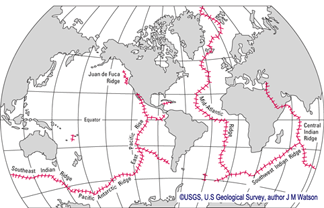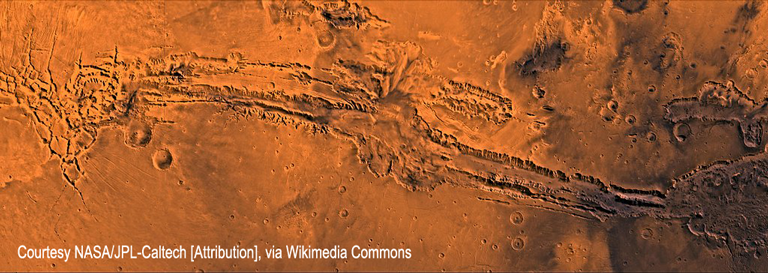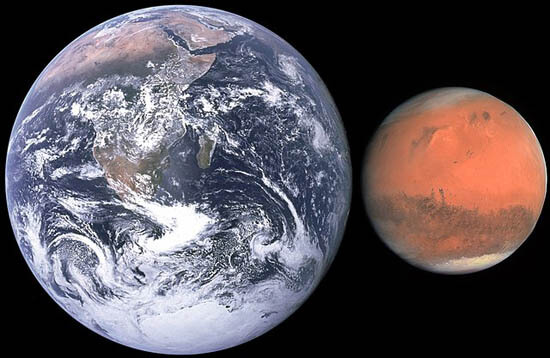Earth and Mars Comparison
Although Earth and Mars share some similarities, they also have many differences. They are both members of the inner solar system that consists of the five planets closest to the Sun and the asteroid belt. The accepted outer planets in the solar system are gas giants, but Earth and Mars have rocky surfaces that can be walked on. They are both inclined to their orbits that causes seasons that are similar, but still different.
Mars is about half the size of Earth, with a gravity at the surface that is 1/3 the amount of Earth's. At the surface of Earth, the atmosphere exerts a tremendous pressure to which human beings have been adapted. On Mars there is no such pressure, so the blood in human veins and arteries would just boil away. In no case will humans exploring Mars ever be able to remove their space helmets, no matter how many movies Hollywood makes that say differently. Mars is so small that it could not hold on to liquid water at the surface. Whatever water may have been there in the past has long since boiled away and left Mars' atmosphere. Only water trapped in ice and beneath the surface may have been able to remain on Mars intact.
| Characteristic | Earth | Mars |
|---|---|---|
| Diameter | 12,756 km | 6,792 km |
| Orbital period (sidereal) | 365 days | 687 days |
| Revolutionary period | 23:56:4 | 24:37 |
| Axial Tilt (inclination) | 23.4 deg | 25.2 deg |
| Distance from Sun (average) | 149.6 million km | 227.9 million km |
Mars is devoid of any water on the surface in a liquid state while the surface of Earth is two-thirds water. Mars' atmosphere consists of 95% carbon dioxide, 2.7% nitrogen,and only traces of oxygen, argon, and carbon monoxide. Earth has a mixture of 78% nitrogen, 21% oxygen, and traces of other elements in its 5-layered atmosphere. Mars has dust storms that can cover the entire surface, filling its meager atmosphere with particles. Earth has a complex water cycle where clouds grow and rain falls to the ground. Dust particles in a Mars storm settle out gradually. Mars does have some clouds made of carbon dioxide and perhaps water crystals. They appear sometimes around the giant volcanoes and in the morning sky. Another key difference between Earth and Mars is albedo. Mars albedo is .15, meaning that 15 percent of of the light that falls on it from distant Sol is reflected back into space. Thirty-one percent of the light that reaches Earth is reflected back into space. Earth's appearance is blue and white, due to water, while the land masses occasionally poke out between the clouds. From a distance planet Earth appears bright with a moon that doesn't stray far from its primary. Both planets have ice caps; Mars caps disappear during the Summer while Earth's ice cap in the north only recently began melting during the Summer.
 Earth has a complex crustal surface, with continents drifting on the mantle, the central core being liquid iron. The largest feature on the planet is the mid-oceanic ridge that wraps around the entire planet like stitches on a baseball. It cannot be detected from space at visible wave-lengths due to the water that covers Earth's trenches. Nevertheless, this is the largest crustal feature of the planet. Earth has a complex magnetic field that produces the Van Allen Belts protecting inhabitants from dangerous light wavelengths. Mars magnetic field can be detected at certain locations suggesting there once may have been a planet-wide field. Mars has a mysterious crustal dichotomy as the northern hemisphere is very flat, flatter than Earth's ocean floors, while the south hemisphere is at a higher elevation, pocked with craters. It may be that a giant impact produced the northern smoother surface.
Earth has a complex crustal surface, with continents drifting on the mantle, the central core being liquid iron. The largest feature on the planet is the mid-oceanic ridge that wraps around the entire planet like stitches on a baseball. It cannot be detected from space at visible wave-lengths due to the water that covers Earth's trenches. Nevertheless, this is the largest crustal feature of the planet. Earth has a complex magnetic field that produces the Van Allen Belts protecting inhabitants from dangerous light wavelengths. Mars magnetic field can be detected at certain locations suggesting there once may have been a planet-wide field. Mars has a mysterious crustal dichotomy as the northern hemisphere is very flat, flatter than Earth's ocean floors, while the south hemisphere is at a higher elevation, pocked with craters. It may be that a giant impact produced the northern smoother surface.
Another unique Mars feature is the Tharsis Bulge, a volcanic region that is elevated above the average surface by 9 km. The region is over 1800 km across. This is where Mars keeps its giant volcanoes. Olympus Mons is the largest at 624 km or 374 miles in diameter. It has an elevation of 25 km or 16 miles high. The Tharsis ridge includes 3 giant volcanoes Ascraeus Mons, Pavonis Mons, and Arsia Mons.(And many more as well.) Earth's highest mountain, Everest at 8.8 km, is 5 km shorter than Elysium Mons (13,862 km.) that is not as high as any of the 3 volcanoes on the Tharsis Ridge. At the eastern edge, a huge canyon known as Valles Marineris is almost certainly formed by the same forces that built the Tharsis region. All this volcano building caused the crust to split open. Valles Marineris, discovered by a space probe, is 4,000 km or 2,500 miles long. Earth's Grand Canyon in N. America is 446 km or 277 miles long, up to 29 km (18 mi.) wide and over a mile in depth (1,857 m or 6,093 ft.)

The deepest feature on Mars is the gigantic crater Hellas Basin at -7,152 km elevation. Earth can boast of the deepest trench in the solar system, at the southern end of the Mariana Trench, Challenger Deep at -10,924 km below sea level.
The title image for this page is courtesy NASA.
Some helpful links
Find out which side of Mars is visible while you are out viewing the red planet through a telescope. Sky & Telescope magazine features an interactive application, Mars profiler. Use this tool to find out what side of the martian surface is currently in your viewfinder or check up on the time of your observation.
Earth - Mars Comparison Information On-line
All about Mars - from NASA
Comparing the Atmospheres of Mars and Earth - From the European Space Agency (ESA)
Earth-Mars comparison from Phoenix Mars Mission
Earth and Mars as different as they are alike poster from NASA for the classroom
Planet Mars - from National Geographic. Lots of information on the red planet and links to other resources
For information on Mars at Opposition go to Astra's Mars at Opposition page.
For more general Observing information check out Astra's Observers page.
If you love the red planet as much as Astra does, check out Astra's Star Gate's 3 Faces of Mars page!
